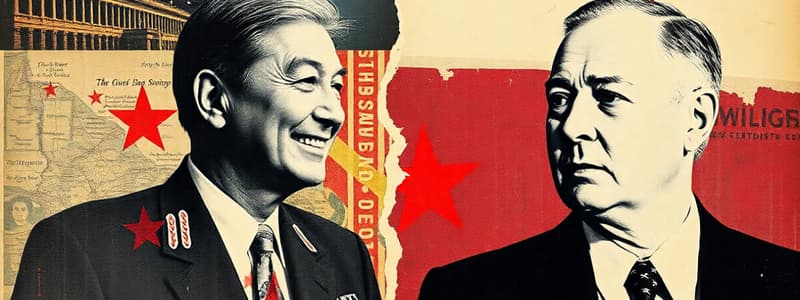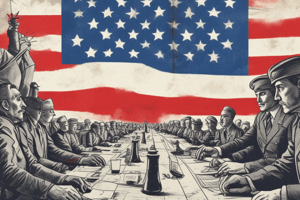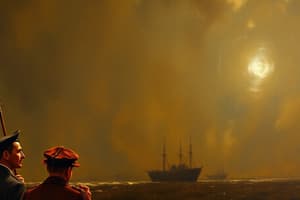Podcast
Questions and Answers
Which of the following best illustrates the concept of Mutually Assured Destruction (MAD) during the Cold War?
Which of the following best illustrates the concept of Mutually Assured Destruction (MAD) during the Cold War?
- The use of proxy wars to weaken the opponent without directly engaging in conflict, thus avoiding nuclear confrontation.
- The understanding that any nuclear attack by one superpower would inevitably result in a retaliatory strike, leading to catastrophic consequences for both. (correct)
- The build-up of conventional forces by both the Warsaw Pact and NATO to deter a ground invasion.
- A treaty between the US and the Soviet Union to eliminate all nuclear weapons.
How did the Marshall Plan aim to prevent the spread of communism in post-World War II Europe?
How did the Marshall Plan aim to prevent the spread of communism in post-World War II Europe?
- By providing military aid and training to European countries to resist Soviet aggression.
- By establishing a military alliance, NATO, to counter Soviet influence.
- By offering economic assistance to rebuild war-torn economies, thereby reducing the appeal of communism. (correct)
- By supporting democratic movements and elections in Eastern European countries.
What was the primary goal of the 'containment' policy adopted by the United States during the Cold War?
What was the primary goal of the 'containment' policy adopted by the United States during the Cold War?
- To economically isolate communist countries through trade embargoes.
- To prevent the spread of communism beyond its existing borders. (correct)
- To negotiate peaceful coexistence with the Soviet Union and its allies.
- To actively overthrow communist regimes around the world.
What was the significance of the Tet Offensive in the Vietnam War?
What was the significance of the Tet Offensive in the Vietnam War?
How did Glasnost and Perestroika impact the Soviet Union?
How did Glasnost and Perestroika impact the Soviet Union?
What role did the Domino Theory play in shaping US foreign policy during the Cold War?
What role did the Domino Theory play in shaping US foreign policy during the Cold War?
What was the primary reason for the construction of the Berlin Wall in 1961?
What was the primary reason for the construction of the Berlin Wall in 1961?
How did China's involvement in the Korean War impact its relationship with the United States?
How did China's involvement in the Korean War impact its relationship with the United States?
Which Soviet action prompted the United States to respond with the Berlin Airlift?
Which Soviet action prompted the United States to respond with the Berlin Airlift?
What was a significant consequence of the Cuban Missile Crisis?
What was a significant consequence of the Cuban Missile Crisis?
Flashcards
Mao Zedong
Mao Zedong
Leader of the Chinese Communist Revolution and the People's Republic of China from 1949-1976.
Collectivization
Collectivization
Policy of forced consolidation of individual farms into collective farms, mainly in China and the Soviet Union.
Great Leap Forward
Great Leap Forward
An economic and social campaign by the Communist Party of China from 1958 to 1962, which aimed to rapidly transform China from an agrarian economy into a communist society through industrialization and collectivization.
Cultural Revolution
Cultural Revolution
Signup and view all the flashcards
Yalta & Potsdam Conferences
Yalta & Potsdam Conferences
Signup and view all the flashcards
Churchill's Iron Curtain speech
Churchill's Iron Curtain speech
Signup and view all the flashcards
Marshall Plan
Marshall Plan
Signup and view all the flashcards
Berlin Blockade & Airlift
Berlin Blockade & Airlift
Signup and view all the flashcards
Red Scare
Red Scare
Signup and view all the flashcards
Mutually Assured Destruction
Mutually Assured Destruction
Signup and view all the flashcards





